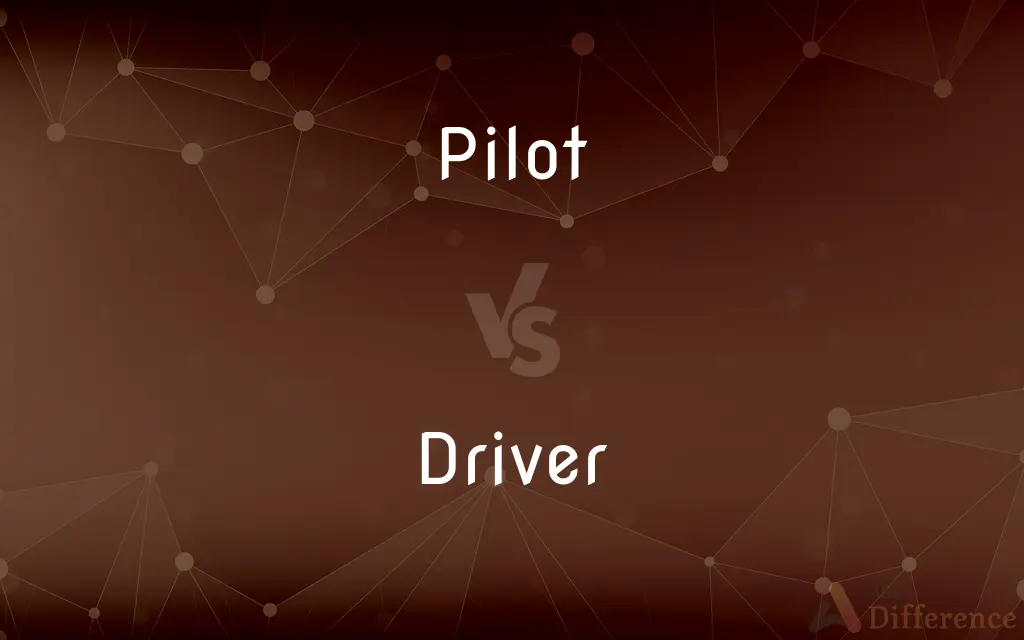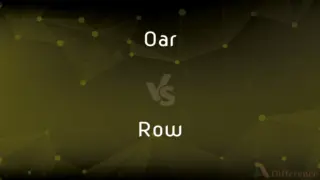Pilot vs. Driver — What's the Difference?
By Fiza Rafique & Urooj Arif — Updated on March 18, 2024
A pilot operates aircraft, focusing on navigation and safety in the air, while a driver controls vehicles on land, emphasizing road rules and vehicle handling.

Difference Between Pilot and Driver
Table of Contents
ADVERTISEMENT
Key Differences
A pilot is trained to operate aircraft, which includes airplanes, helicopters, and other types of airborne vehicles. Their primary focus is on navigation, safety protocols in the air, and managing complex flight systems. Whereas a driver is responsible for controlling vehicles on land, such as cars, trucks, and motorcycles, with an emphasis on adhering to road rules, vehicle handling, and ensuring the safety of passengers and cargo.
The training for pilots is extensive and specialized, covering aerodynamics, navigation, meteorology, and emergency procedures. This education prepares them to handle the complexities of flight and the challenges of varying weather conditions and emergency situations. On the other hand, driver training typically involves understanding traffic laws, basic vehicle maintenance, and developing safe driving habits, which is generally less comprehensive compared to pilot training.
Pilots must be licensed by aviation authorities and often undergo rigorous medical examinations and continuous training to ensure they remain qualified to fly. The licensing process includes written exams, practical tests, and hours of flight experience. Drivers, while also needing a license to operate vehicles legally, usually go through a less stringent process that includes a written test, a practical driving test, and may include periodic renewals without the need for additional testing.
The environment in which pilots and drivers operate is vastly different. Pilots navigate the three-dimensional airspace, dealing with factors like altitude, air traffic control, and changing weather conditions. Drivers navigate roads and highways, contending with traffic, road conditions, and pedestrian safety. These operational environments dictate the unique skill sets and situational awareness required for each role.
Despite these differences, both pilots and drivers share the fundamental responsibility of transporting people or goods safely and efficiently. They must both be adept at managing the operation of their vehicles, maintaining concentration over long periods, and making quick decisions in response to unexpected situations.
ADVERTISEMENT
Comparison Chart
Vehicle Type
Aircraft (planes, helicopters, etc.)
Land vehicles (cars, trucks, motorcycles, etc.)
Focus
Navigation, safety in air, flight systems management.
Road rules, vehicle handling, safety of passengers and cargo.
Training
Extensive, covering aerodynamics, navigation, meteorology.
Traffic laws, basic vehicle maintenance, safe driving habits.
Licensing Authority
Aviation authorities (FAA, EASA, etc.)
Local DMV or equivalent road traffic authority.
Operating Environment
Three-dimensional airspace, variable weather.
Roads, highways, variable road conditions.
Compare with Definitions
Pilot
Aircraft operation.
The pilot navigated through the storm safely.
Driver
Vehicle control on land.
The driver expertly maneuvered the car through narrow streets.
Pilot
Flight safety management.
Pilots undergo continuous training to ensure passenger safety.
Driver
Vehicle maintenance knowledge.
The driver routinely checks the vehicle to ensure it's in good condition.
Pilot
Navigation expertise.
With years of experience, the pilot adeptly managed the long-haul flight.
Driver
Navigational skills on roads.
Using her knowledge of the area, the driver took the quickest route.
Pilot
Emergency procedures proficiency.
The pilot executed an emergency landing flawlessly.
Driver
Adherence to road rules.
As a professional driver, he always follows speed limits and traffic signs.
Pilot
Air traffic communication.
The pilot communicated with air traffic control to adjust the flight path.
Driver
Safe transportation of passengers.
She prides herself on her safe driving record.
Pilot
One who operates or is licensed to operate an aircraft in flight.
Driver
One that drives, as the operator of a motor vehicle.
Pilot
One who, though not belonging to a ship's company, is licensed to conduct a ship into and out of port or through dangerous waters.
Driver
A tool, such as a screwdriver or hammer, that is used for imparting forceful pressure on another object.
Pilot
The helmsman of a ship.
Driver
A machine part that transmits motion or power to another part.
Pilot
One who guides or directs a course of action for others.
Driver
A piece of software that enables a computer to communicate with a specific hardware device. Also called device driver.
Pilot
The part of a tool, device, or machine that leads or guides the whole.
Driver
A golf club with a wide head and a long shaft, used for making long shots from the tee.
Pilot
A pilot light, as in a stove.
Driver
(Nautical) A jib-headed spanker.
Pilot
A television program produced as a prototype of a series being considered for adoption by a network.
Driver
One who drives something, in any sense of the verb drive.
Pilot
To serve as the pilot of (a plane, for example).
Driver
Something that drives something, in any sense of the verb drive.
Pilot
To steer or control the course of
Piloted the visitors around the city.
Driver
A person who drives a motorized vehicle such as a car or a bus.
The requirement that every moving vehicle or combination of vehicles shall have a driver is deemed to be satisfied while the vehicle is using an automated driving system which complies with domestic technical regulations, and any applicable international legal instrument, ... and domestic legislation governing operation.
Pilot
Serving as a tentative model for future experiment or development
A pilot project.
Driver
A person who drives some other vehicle.
Pilot
Serving or leading as guide.
Driver
A pilot (person who flies aircraft).
Pilot
A person who steers a ship, a helmsman.
Driver
(computing) A device driver; a program that acts as an interface between an application and hardware, written specifically for the device it controls.
Pilot
A person who knows well the depths and currents of a harbor or coastal area, who is hired by a vessel to help navigate the harbor or coast.
Driver
(golf) A golf club used to drive the ball a great distance.
Pilot
A guide book for maritime navigation.
Driver
(nautical) a kind of sail, smaller than a fore and aft spanker on a square-rigged ship, a driver is tied to the same spars.
Pilot
An instrument for detecting the compass error.
Driver
A mallet.
Pilot
A pilot vehicle.
Driver
A tamping iron.
Pilot
A person authorised to drive such a vehicle during an escort.
Driver
A cooper's hammer for driving on barrel hoops.
Pilot
A guide or escort through an unknown or dangerous area.
Driver
A screwdriver.
Pilot
Something serving as a test or trial.
We would like to run a pilot in your facility before rolling out the program citywide.
Driver
One who, or that which, drives; the person or thing that urges or compels anything else to move onward.
Pilot
(mining) The heading or excavation of relatively small dimensions, first made in the driving of a larger tunnel.
Driver
The person who drives beasts or a carriage; a coachman; a charioteer, etc.; hence, also, one who controls the movements of a any vehicle.
Pilot
(aviation) A person who is in charge of the controls of an aircraft.
Driver
An overseer of a gang of slaves or gang of convicts at their work.
Pilot
(television) A sample episode of a proposed TV series produced to decide if it should be made or not. If approved, typically the first episode of an actual TV series.
Driver
A part that transmits motion to another part by contact with it, or through an intermediate relatively movable part, as a gear which drives another, or a lever which moves another through a link, etc. Specifically:
Pilot
(rail transport) A cowcatcher.
Driver
The driving wheel of a locomotive.
Pilot
(motorsport) A driver.
Driver
The after sail in a ship or bark, being a fore-and-aft sail attached to a gaff; a spanker.
Pilot
A pilot light.
Driver
An implement used for driving;
Pilot
One who flies a kite.
Driver
The operator of a motor vehicle
Pilot
A short plug, sometimes made interchangeable, at the end of a counterbore to guide the tool.
Driver
Someone who drives animals that pull a vehicle
Pilot
Made or used as a test or demonstration of capability.
A pilot run of the new factory
The pilot plant showed the need for major process changes.
Driver
A golfer who hits the golf ball with a driver
Pilot
Used to control or activate another device.
A pilot light
Driver
(computer science) a program that determines how a computer will communicate with a peripheral device
Pilot
Being a vehicle to warn other road users of the presence of an oversize vehicle/combination.
A pilot vehicle
Driver
A golf club (a wood) with a near vertical face that is used for hitting long shots from the tee
Pilot
(transitive) To control (an aircraft or watercraft).
Pilot
(transitive) To guide (a vessel) through coastal waters.
Pilot
(transitive) To test or have a preliminary trial of (an idea, a new product, etc.)
Pilot
To serve as the leading locomotive on a double-headed train.
Pilot
One employed to steer a vessel; a helmsman; a steersman.
Pilot
Specifically, a person duly qualified, and licensed by authority, to conduct vessels into and out of a port, or in certain waters, for a fixed rate of fees.
Pilot
Figuratively: A guide; a director of another through a difficult or unknown course.
Pilot
An instrument for detecting the compass error.
Pilot
The cowcatcher of a locomotive.
Pilot
One who flies, or is qualified to fly, an airplane, balloon, or other flying machine.
Pilot
A short plug at the end of a counterbore to guide the tool. Pilots are sometimes made interchangeable.
Pilot
The heading or excavation of relatively small dimensions, first made in the driving of a larger tunnel.
Pilot
A filmed or taped episode of a proposed television series, produced as an example of the series. It may be shown only to those television broadcast executives who may decide whether to buy the rights to the series, or aired to test viewer reaction or to interest sponsors. Also called pilot film or pilot tape.
Pilot
To direct the course of, as of a ship, where navigation is dangerous.
Pilot
Figuratively: To guide, as through dangers or difficulties.
Pilot
To fly, or act as pilot of (an aircraft); to operate (an airplane).
Pilot
Someone who is licensed to operate an aircraft in flight
Pilot
A person qualified to guide ships through difficult waters going into or out of a harbor
Pilot
A program exemplifying a contemplated series; intended to attract sponsors
Pilot
An original model on which something is patterned
Pilot
Small auxiliary gas burner that provides a flame to ignite a larger gas burner
Pilot
An inclined metal frame at the front of a locomotive to clear the track
Pilot
Fly a plane
Pilot
Act as the navigator in a car, plane, or vessel and plan, direct, plot the path and position of the conveyance;
Is anyone volunteering to navigate during the trip?
Who was navigating the ship during the accident?
Common Curiosities
How does the work environment of a pilot differ from that of a driver?
Pilots operate in the three-dimensional airspace, dealing with factors like altitude and weather, whereas drivers navigate roads and traffic conditions.
What are the main responsibilities of a pilot vs. a driver?
A pilot's main responsibilities include aircraft operation, navigation, and safety in the air, while a driver focuses on controlling vehicles on land, adhering to road rules, and ensuring passenger and cargo safety.
What qualifications are needed to become a pilot?
To become a pilot, one must undergo extensive training, pass medical exams, and achieve certification through practical and written exams.
Can the skills of a pilot be transferable to driving?
Some skills, like navigation and safety awareness, are transferable, but the specific operational skills are unique to each role.
Is the licensing process for pilots more rigorous than for drivers?
Yes, the licensing process for pilots is more rigorous, involving stricter medical requirements, extensive training, and both practical and written exams.
Do pilots and drivers need to have good communication skills?
Yes, both need good communication skills; pilots must communicate with air traffic control and crew, while drivers need to understand and sometimes convey road and safety instructions.
What impact does technology have on the roles of pilot and driver?
Technology enhances safety and efficiency in both roles, with pilots using advanced navigation systems and drivers benefiting from GPS and safety features like automatic braking.
How does one transition from being a driver to a pilot?
Transitioning requires pursuing aviation training, passing the necessary exams, and obtaining a pilot's license.
Can a driver become a pilot?
A driver can become a pilot if they pursue and complete the required aviation training and licensing process.
What personal qualities are important for pilots and drivers?
Qualities like patience, focus, decision-making ability, and a calm demeanor under pressure are important for both.
What are the challenges faced by pilots and drivers?
Pilots face challenges like weather variability and emergency situations, while drivers deal with traffic, road conditions, and pedestrian safety.
How often do pilots and drivers undergo training?
Pilots undergo continuous training and re-certification, whereas drivers may not need additional training beyond their initial license, except for professional drivers who might receive ongoing training.
Can a driver operate an aircraft in an emergency?
Without proper training, it is highly risky and unlikely for a driver to safely operate an aircraft in an emergency.
What is the importance of situational awareness for pilots and drivers?
Situational awareness is crucial for both to anticipate and react to dynamic conditions and ensure safety.
What are the physical requirements for pilots compared to drivers?
Pilots typically face stricter physical and medical requirements to ensure they can handle the pressures of flying.
Share Your Discovery

Previous Comparison
Oar vs. Row
Next Comparison
Candidature vs. CandidacyAuthor Spotlight
Written by
Fiza RafiqueFiza Rafique is a skilled content writer at AskDifference.com, where she meticulously refines and enhances written pieces. Drawing from her vast editorial expertise, Fiza ensures clarity, accuracy, and precision in every article. Passionate about language, she continually seeks to elevate the quality of content for readers worldwide.
Co-written by
Urooj ArifUrooj is a skilled content writer at Ask Difference, known for her exceptional ability to simplify complex topics into engaging and informative content. With a passion for research and a flair for clear, concise writing, she consistently delivers articles that resonate with our diverse audience.















































